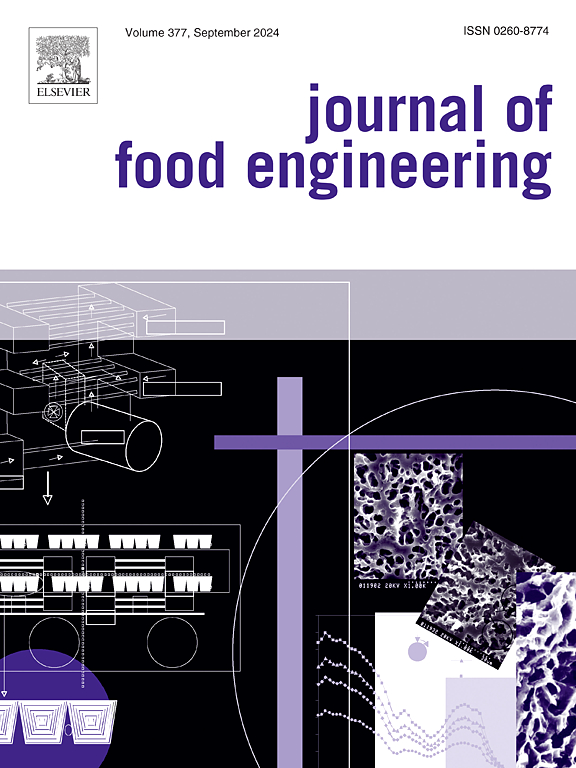Enhanced rheology and lipid absorption modulation in oil-in-water emulsions by aggregation of pea protein isolate and peach gum microspheres
IF 5.8
2区 农林科学
Q1 ENGINEERING, CHEMICAL
引用次数: 0
Abstract
The encapsulation of plant-based materials, particularly in emulsion systems, is gaining attention for enhancing the texture, digestibility, and health benefits of food products. However, the impact of interactions between plant proteins, such as pea protein isolate (PPI), and polysaccharides, like peach gum (PG), on the rheological properties, digestion, and absorption behaviors of emulsions is leaving a gap for further investigation. This study investigates the formulation of four 20 wt% oil-in-water (O/W) emulsions: PPI emulsion (4 wt% PPI), PG emulsion (4 wt% PG), PPI-PG emulsion (2 wt% each in aqueous phase), and a 1:1 mixture of individually prepared PPI and PG emulsions (PPI/PG). The emulsions underwent thermal processing to induce particle aggregation and heteroaggregation, followed by in vitro digestion and ex vivo absorption using a rat small intestine model. The mixed emulsions exhibited significantly higher viscosities and moduli than single emulsions, along with larger and denser microstructures. Consequently, free fatty acids (FFAs) released at the end of digestion were lowest for PPI-PG (33.7 %), followed by PPI (44.92 %), PG (39.93 %), and PPI/PG (36.32 %). Correspondingly, ex vivo FFA absorption was slower for PPI-PG (9.83 %) and PPI/PG (10.81 %) than for PG (14.95 %) and PPI (16.33 %), reflecting reduced enzyme accessibility due to stronger interfacial structures. These findings highlight the potential of PPI-PG and PPI/PG emulsions in creating reduced-fat O/W products, such as mayonnaise and sauces, with higher viscosity but controlled lipid digestion.
豌豆分离蛋白和桃胶微球的聚集增强了水包油乳剂的流变学和脂质吸收调节
植物基材料的包封,特别是在乳剂体系中,正在引起人们的关注,以增强食品的质地、消化率和健康益处。然而,植物蛋白(如豌豆分离蛋白(PPI))和多糖(如桃胶(PG))之间的相互作用对乳剂流变学性质、消化和吸收行为的影响仍有待进一步研究。本研究研究了四种20 wt%水包油(O/W)乳剂的配方:PPI乳剂(4 wt% PPI), PG乳剂(4 wt% PG), PPI-PG乳剂(水相各2 wt%),以及单独制备的PPI和PG乳剂(PPI/PG)的1:1混合物。乳状液经热处理诱导颗粒聚集和异聚集,然后用大鼠小肠模型进行体外消化和体外吸收。混合乳剂的黏度和模量明显高于单一乳剂,微观结构更大、更致密。结果表明,PPI-PG消化末端释放的游离脂肪酸最少(33.7%),其次是PPI(44.92%)、PG(39.93%)和PPI/PG(36.32%)。相应的,相对于PG(14.95%)和PPI/PG (16.33%), PPI-PG(9.83%)和PPI/PG(10.81%)的体外FFA吸收较慢,这反映了由于更强的界面结构而降低了酶的可及性。这些发现强调了PPI-PG和PPI/PG乳剂在制造低脂O/W产品(如蛋黄酱和酱汁)方面的潜力,这些产品具有更高的粘度,但脂质消化受到控制。
本文章由计算机程序翻译,如有差异,请以英文原文为准。
求助全文
约1分钟内获得全文
求助全文
来源期刊

Journal of Food Engineering
工程技术-工程:化工
CiteScore
11.80
自引率
5.50%
发文量
275
审稿时长
24 days
期刊介绍:
The journal publishes original research and review papers on any subject at the interface between food and engineering, particularly those of relevance to industry, including:
Engineering properties of foods, food physics and physical chemistry; processing, measurement, control, packaging, storage and distribution; engineering aspects of the design and production of novel foods and of food service and catering; design and operation of food processes, plant and equipment; economics of food engineering, including the economics of alternative processes.
Accounts of food engineering achievements are of particular value.
 求助内容:
求助内容: 应助结果提醒方式:
应助结果提醒方式:


